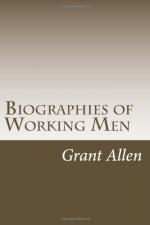The work which finally secured the position of George Stephenson and of his dearly loved locomotive was the Stockton and Darlington railway. Like all the other early railways, it was originally projected simply as a mineral line. Darlington lies in the centre of a rich inland mining district; but the impossibility of getting the coal carried to the sea by cart or donkey, long prevented the opening up of its immense natural wealth. At last, as early as 1817, Edward Pease and a few other enterprising Darlington Quakers determined to build a line of railway from the mining region to Stockton, on the river Tees, where the coal could be loaded into sea-going ships. It was a very long line, compared to any railway that had yet been constructed; but it was still only to be worked by horse-power—to be, in fact, what we now call a tramway, rather than a railway in the modern sense. However, while the plan was still undecided, George Stephenson, who had heard about the proposed scheme, went over to Darlington one day, and boldly asked to see Mr. Pease. The good Quaker received him kindly, and listened to his arguments in favour of the locomotive. “Come over to Killingworth some day and see my engine at work,” said Stephenson, confidently; “and if you do you will never think of horses again.” Mr. Pease, with Quaker caution, came and looked. George put the engine through its paces, and showed off its marvellous capabilities to such good effect that Edward Pease was immediately converted. Henceforth, he became a decided advocate of locomotives, and greatly aided by his wealth and influence in securing their final triumph.
Not only that, but Mr. Pease also aided Stephenson in carrying out a design which George had long had upon his mind—the establishment of a regular locomotive factory, where the work of engine-making for this particular purpose might be carried on with all the necessary finish and accuracy. George himself put into the concern his precious 1000 pounds, not one penny of which he had yet touched; while Pease and a friend advanced as much between them. A factory was forthwith started at Newcastle on a small scale, and the hardworking engine-wright found himself now fully advanced to the commercial dignity of Stephenson and Co. With the gradual growth of railways, that humble Newcastle factory grew gradually into one of the largest and wealthiest manufacturing establishments in all England.
Meanwhile, Stephenson was eagerly pushing on the survey of the Stockton and Darlington railway, all the more gladly now that he knew it was to be worked by means of his own adopted child, the beloved locomotive. He worked at his line early and late; he took the sights with the spirit-level with his own eye; he was determined to make it a model railway. It was a long and heavy work, for railway surveying was then a new art, and the appliances were all fresh and experimental; but in the end, Stephenson brought it to a happy conclusion, and struck at once the death-blow of the old road-travelling system. The line was opened successfully in 1825, and the engine started off on the inaugural ceremony with a magnificent train of thirty-eight vehicles. “Such was its velocity,” says a newspaper of the day, “that in some parts the speed was frequently twelve miles an hour.”




